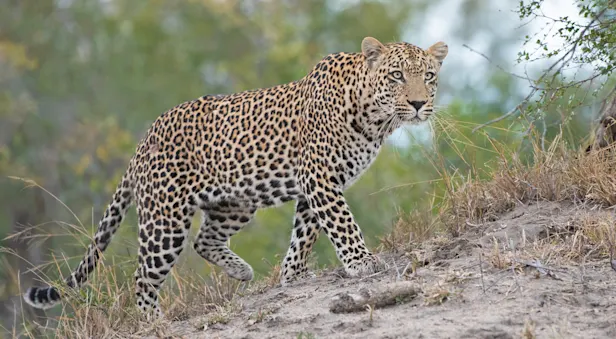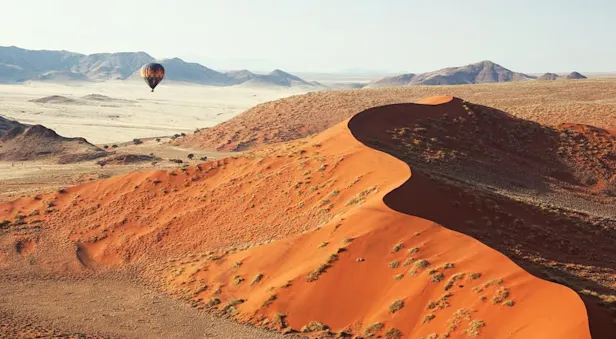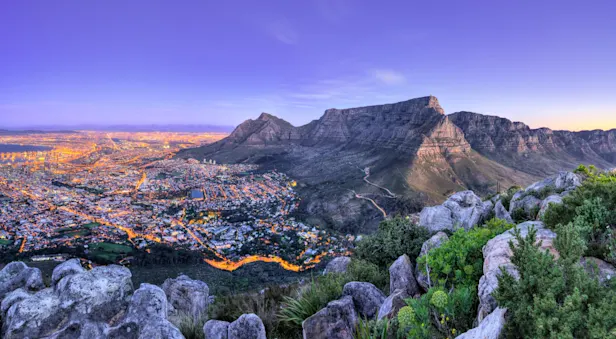Itinerary
Arrive in Victoria Falls, Zimbabwe, where you are met at the airport and transferred to our hotel. Ilala Lodge is the closest accommodation to the mighty cataract that spans the border between Zimbabwe and Zambia, and walking trails from the property lead to magnificent views of the falls. This afternoon, our Expedition Leader leads a private guided tour into Victoria Falls National Park. Witness the world's largest curtain of falling water, which spans more than a mile and plummets 350 feet into the rocky Zambezi Gorge below. View the falls from varying vantage points via the network of trails along the rim as we walk through the rain forest microclimate created by the profuse spray. This evening, we gather for a welcome dinner as our Expedition Leader shares an overview of the diverse safari adventures to come.
Day 2: Victoria Falls / Chobe National Park, Botswana / Impalila Island, Namibia
This morning, we depart Zimbabwe and cross into Botswana for a game drive in Chobe National Park. One of the country's premier wildlife reserve, Chobe is renowned for its big game, which we seek on an overland 4x4 safari. The Chobe River flowing through the park is a lifeline for bountiful wildlife, including Africa’s largest elephant population—as many as 70,000 of Botswana's 130,000 elephants live within the park bounds. We also seek out buffalo, lion, leopard and more. Then it's time to cross another border into Namibia to reach a new ecolodge on Impalila Island on the Caprivi Strip. Tucked away from the larger accommodations that border Chobe National Park, this intimate lodge—exclusively for Nat Hab guests—offers a more secluded location and excellent access to the park and Chobe River for both land- and water-based exploration.
Day 3: Exploring the Chobe River Region
With a second day in the Chobe region, we have ample time to explore it from a variety of perspectives. A private boat cruise on the Chobe River’s channels and inlets gives us exhilarating vantage points to search for hippo, crocodile and myriad bird species that frequent this area, along with its famous elephants. We also meet villagers who live near our lodge on Impalila Island to learn about their culture, traditions and commitment to local conservation efforts. We are in the heart of the Kavango-Zambezi Transfrontier Conservation Area (KAZA), a 106-million-acre expanse spanning five nations—Angola, Botswana, Namibia, Zambia, and Zimbabwe—where diverse ecosystems converge. Established in 2011, KAZA represents the world's largest transboundary conservation landscape, uniting governments, environmental groups like WWF, and the Peace Parks Foundation. Together, they aim to safeguard wildlife, empower local communities, and offer a sustainable tourism experience, showcasing the interconnected efforts crucial for KAZA's success in preserving Africa's immense biodiversity. Return in the evening to our comfortable island retreat, mulling the day’s wonders around a campfire under a starry sky.
Day 4: Kasane / Lake Kariba—Board Zimbabwean Dream
Return to Kasane this morning and fly on to Kariba where we board our boutique riverboat Zimbabwean Dream. This deluxe three-deck vessel, ideal for cruising the vast expanse of Lake Kariba, is our floating safari base for the next three days. The lake was created when the Zambezi River was dammed in the late 1950s, and it is the largest manmade body of water in the world, more than 140 miles long and 25 miles across at its widest point. Today, the dam provides electricity for 70% of Zimbabwe's residents, and the resulting lake is a haven for a wide array of waterbirds and wildlife along the border of Zimbabwe and Zambia. Lake Kariba's size makes it feel more like an inland sea, and given how few visitors this region sees, we’re assured a serene experience. On board we find a relaxing rhythm, typically making two excursions per day, leaving the ship each morning and afternoon for wildlife-focused activities via smaller boats and safari vehicles.
Days 5 & 6: Exploring Lake Kariba / Matusadona National Park
The unusual landscapes of Lake Kariba provide diverse contexts for exploration. In some places, drowned trees still jut from the water’s calm surface. Via covered pontoon boat, cruise close to the shoreline and reed-fringed backwaters that shelter a variety of animals and birds. Hippos congregate along the shoreline, subtly revealing their presence as their ears and eyes peek above the water's surface. And we often see crocodiles hauled out on the lake's edge.
Along the way, explore Matusadona National Park, where we disembark for a land safari. Bordered by the Sanyati and Ume rivers, the park's 540 square miles of untouched terrain is home to elephant, Cape buffalo, impala, waterbuck, side-striped jackal and more. We’ll also look for lions—though elusive, two prides inhabit the park, about 40 in all—and they are adept hunters, even killing crocodiles on occasion. We're sure to see lots of birds, with frequent sightings of Egyptian goose, marabou stork, saddle-billed stork, Goliath heron, African skimmer and the coveted African fish eagle. Some of the park's wildlife may be descendants of the more than 6,000 animals rescued during Operation Noah, following completion of the dam in 1959. As the water level rose, many creatures struggled to survive on ground that was gradually becoming submerged. A team of intrepid rangers moved large mammals, big cats, impala herds and more to safety into Matusadona, transporting many on wooden rafts.
After each full day of discovery, return to the ship to watch the sun set blood-red over the water, dine on gourmet cuisine including freshly caught bream and tilapia from the lake, and head up to the sundeck after dark to watch the sparkling stars in the black night sky.
Days 7–9: Kariba / Hwange National Park
Disembark this morning and fly to Hwange National Park. From Davison's Camp, we have exclusive proximity to outstanding wildlife viewing. Bordering the Kalahari Desert on Zimbabwe’s western edge, Hwange is the country's largest and most renowned national park. Its 5,600 square miles are comprised mostly of desert sandveld with teak and mopane woodlands and dry acacia scrub interspersed with salt pans, grasslands and granite outcrops. The varied habitat is home to huge herds of elephant and buffalo, plus a vital predator population including lion, leopard and cheetah. Other game frequently on view includes zebra, giraffe, sable, roan, blue wildebeest and impala. We also keep an eye out for endangered gemsbok, brown hyena and African wild dog. The variety of birdlife is among the best in Africa, with more than 400 species. While our focus is game drives, a viewing platform at camp offers relaxed afternoon wildlife viewing at close range. Bush walks with renowned guides are a highlight, as safety permits.
Day 10: Hwange / Victoria Falls / Depart
Our safari comes to a close today as we leave the plains of Hwange behind, flying by light aircraft back to Victoria Falls where we meet departing flights.






























